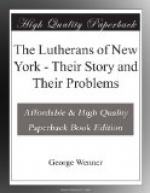[illustration: “John Christopher Kunze”]
He was instrumental in 1785 in reorganizing the New York Ministerium. This work was begun in 1775 by Frederick Muehlenberg, but had been given up for a while, probably on account of the war.
As a writer he is credited in Dr. Morris’ Bibliotheca Lutherana with eight books of which he was the author or editor, from Hymns and Poems to A History of the Lutheran Church and A New Method of Calculating the Great Eclipse of 1806.
These and many other things must be set to his credit. For what he accomplished he deserves a large place in the history of our Church in this city. But with all his gifts he was unable to cope with the chief problem which confronted our Church at the close of the eighteenth century, that of the English language.
There had been a demand for English services ever since the middle of the century. The descendants of the Dutch families had all become English. The need of English had been met in part by the elder Muehlenberg and his successors, Weygand and Hauseal, in Trinity Church, doubtless also by Frederick Muehlenberg in the Swamp Church.
After the, Revolution (1784) the United Congregations certainly made some provision for English although it was inadequate. In 1794 the younger people petitioned for occasional services in a language which they could understand. Dr. Kunze himself made some attempts to handle the English, but his faulty pronunciation so amused the young people that he gave it up. He appointed a young man by the name of Strebeck to assist him in ministering to the English members of the congregation. Strebeck at this time was a Methodist, although he had been confirmed in a Lutheran Church in Baltimore. Under Kunze’s influence he again joined the Lutherans.
“A Hymn and Prayer Book for the use of such Lutheran Churches as use the English language,” published by Kunze in 1795, and another by Streback [sic] in 1797, show that serious efforts were made to meet the wants of the English-speaking members.
Finally, on June 25th, 1797, a separate congregation was organized entitled The English Lutheran Church in the City of New York. (This was the corporate name, although it was subsequently known as Zion Church.) Strebeck was chosen pastor. Land was rented on Pearl Street opposite City Hall Place and a frame church was built.
The incorporation of the church was reported to the Ministerium which met at Rhinebeck. The following reply was given under date of September 1st, 1797:
“Upon reading a letter from New York signed by Henry Heiser, Lucas Van Buskirk and L. Hartman, representing that they have erected an English Lutheran Church, on account of the inability of their children to understand the German language:
RESOLVED, That it is never the practice in an Evangelical Consistory to sanction any kind of schism; that if the persons who signed the letter wish to continue their children in the Lutheran Church connection in New York, they earnestly recommend them the use of the German School, and in case there is no probability of any success in this particular, they herewith declare that they do not look upon persons who are not yet communicants of a Lutheran Church as apostates in case they join an English Episcopal Church.




